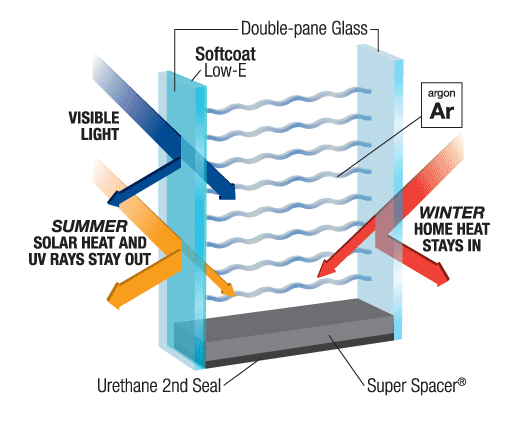
In this post, you will learn...
- Qualities of an energy-efficient window
- How replacement windows can help your home maintain a consistent temperature all year round
- Options for window frame materials
Choosing the appropriate replacement windows for your home or business might prove difficult and tedious if you do not know much about energy efficiency. When choosing windows that will keep your home cool in the summer and warm in the winter, it’s important to consider several factors, including your geographic location, climate and more.
Energy-Efficient Windows
Windows are not only a major element of home décor and curb appeal, but they also affect ventilation, amount of light, room temperature and overall comfort of your home. Replacement windows contribute to architectural characteristics, conveying period and style. When choosing replacement windows, be sure the styles selected suit your home’s aesthetic and practical needs. Replacement windows come in different sizes, custom shapes and window styles, which are key considerations before making a buying decision. Energy-efficient replacement windows are preferable because they keep your home comfortable. Whether you live in a warm climate where an air conditioner is needed or a cooler climate where you want to keep warm air in, energy-efficient windows can limit the transfer of heat and cold through glass, providing the perfect environment for your home.
Energy-efficient windows are constructed using multiple components that work together to aid in the insulation properties of a window. To keep your home cool (or warm) with replacement windows, consider the following:
Low-E Windows
Low-E stands for low emissivity, which is the ability of a window to reflect heat, rather than absorbing it. Low-E is a multi-layer coating that is applied to the interior pane(s) of glass during the manufacturing process. This coating can minimize the amount of ultraviolet and infrared light that passes through the glass in your windows. The coating acts as insulation, slowing down the transfer of heat or cold through the panes of glass. An energy-efficient window fitted with low-emissivity coating can significantly decrease the overall heating, lighting and cooling costs of your home.

Gas-Filled Windows
Energy-efficient windows typically utilize a gas that is placed between panes of glass. The most popular gas is Argon. The gas acts as an additional insulation barrier to slow down the transfer of heat and cold through the panes of glass. If your home is wasting energy due to inefficient windows and drafty doors, it may be time to consider installing gas-filled windows.
Low-Conductance Spacers
The use of low-conductivity spacers and seals between the panes of glass keep the gas in place and further reduce transfer of heat and cold through the window.
Multiple Panes of Glass
The more panes of glass used in a window, the better the window’s overall energy efficiency. The most energy-efficient windows utilize all components: Low-E coatings, gas-fill, low-conductivity spacers and triple-pane glass. Together, these components can help keep your home at a consistent temperature any time of year.
Frame Materials
 Incorporating certain materials within the frame of a window will boost your room’s insulation capabilities and allow for a consistent temperature throughout your home. Different materials have unique properties that affect a window’s insulation properties. See below for window material options and how they affect the insulation of your home.
Incorporating certain materials within the frame of a window will boost your room’s insulation capabilities and allow for a consistent temperature throughout your home. Different materials have unique properties that affect a window’s insulation properties. See below for window material options and how they affect the insulation of your home.
- Vinyl Windows - Vinyl is an ideal choice for replacement windows because it can be created using multiple air chambers to create insulation pockets which help in reducing the transfer of heat and cold through the window frame. Vinyl is also easy to maintain and needs no regular upkeep. These windows have endless finishing options, such as interior woodgrain finish and custom colors to match the exterior of your home.
- Wood Windows - Wood is a good choice for keeping a consistent temperature in your home. But the biggest problem with wood windows is the regular maintenance needed to keep the windows looking and performing their best. Sanding, staining and painting are needed frequently, and anyone who has ever had to do this understands the chore an entire house of wood windows creates. However, you can purchase vinyl replacement windows with a wood finish to get the same look and insulation properties without the constant upkeep.
- Aluminum Windows - Aluminum does not have any insulating properties and transfers heat and cold extremely well. If you are looking for energy-efficient windows, aluminum is not a material you want to consider.
Fitting your home with custom replacement windows that possess these insulating properties can not only improve the aesthetics of your home, but can also significantly improve the comfort and energy efficiency of your space.
Want to learn more about keeping your home energy efficient with replacement windows? Request a free in-home estimate from Stanek® Windows today.
 You May Also Be Interested In:
You May Also Be Interested In: